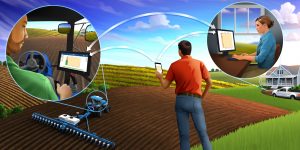Will Blockchain Transform Agriculture?
May 7, 2019

Blockchain is the latest buzzword in many business sectors today, and agriculture is no exception. A transparent and secure digital ledger system that allows two parties to conduct a transaction without the need for a trusted intermediary, blockchain captured headlines as the digital backbone of the cryptocurrency Bitcoin.
In recent months it has gained further attention as businesses explore ways to leverage blockchain technology to save money, improve transparency and reduce human error.
 As technology pundits speculate on how blockchain will be a game-changer, business leaders are looking for ways to tap into the technology.
As technology pundits speculate on how blockchain will be a game-changer, business leaders are looking for ways to tap into the technology.
“I’m very excited about this,” says Prakash Iyer, Senior Vice President of Software Architecture and Strategy with Trimble Inc. “It’s going to define a whole new paradigm of building applications — not just blockchain applications, but how you apply blockchain to transactional applications, settlement applications or food traceability applications.”
Iyer is leading the charge at Trimble to identify key ways that blockchain can be incorporated into various aspects of the global technology company, which develops transformational technology for sectors such as construction, geospatial, transportation and agriculture.
He says the real opportunity lies in early development of global industry standards that will guide the long-term adoption of blockchain.
“The way blockchain evolved, there’s really no agreed-upon standard,” Iyer explains. “We could play a leading role by helping to define that standard. It’s about showing thought leadership — because this is not just a technology play, it’s more of a business play, and a collaborative business play.”
The goal would be to create an ecosystem with key industry leaders, including customers and business partners both inside and outside the Trimble fold, to identify challenges and set industry standards.
“Our success will be defined by how well we can collaborate and create that ecosystem of players and bring those people together.”
In addition to leading industry collaboration and standardization around blockchain, Iyer identified two other key areas of focus:
1. Agriculture Transactions
The first and most obvious application of blockchain technology is in any transaction that requires a trusted third party, such as an organization that provides the security and verification for digital transactions. (In other words, instead of needing a bank or some other institution to verify a money transfer, you could use blockchain to cut out the middleman.)
“It offers open-ledger trust and transparency,” says Iyer. “So you would no longer need a third party for that.”
Companies have already implemented this in the grain trade, most notably Louis Dreyfus Co. selling soybeans to China in what was billed as the first agricultural commodity trade using blockchain.
 Specifically for Trimble, which sells food traceability software under the banner HarvestMark and Trimble Ag Software, Iyer is investigating areas where blockchain could be used to track fresh produce.
Specifically for Trimble, which sells food traceability software under the banner HarvestMark and Trimble Ag Software, Iyer is investigating areas where blockchain could be used to track fresh produce.
“I see this as a much broader application than food traceability,” he notes. “It could be applied anywhere provenance is involved, where you’re tracking origin to destination. There are some real problems in supply-chain management right now that could hugely benefit from being able to track exactly what happened from Point A to Point B.”
Bob Wold agrees. The World Wide Director of Engineering for Trimble’s Agriculture Division says blockchain technology could significantly raise the bar when it comes to transparency and integrity across the food supply chain.
“Imagine a world where every meter of land is put into this public ledger,” Wold says. “If you’re a custom applicator, you report what you did. If you’re an agronomist who did some scouting, your reports are associated with that land’s ID. This data follows the product all the way to the end consumer, and it can’t be tampered with.”
2. Land Ownership and Surveying
The second key opportunity is in the area of land ownership and land surveying.
“Today, you could do all the measurements and then five years later go to the county office and see that the records have changed,” says Iyer. “Blockchain makes that immutable so it can not be altered, and that’s a value-add.”
Reducing human error in paperwork and accounting is one of the greatest advantages of blockchain, especially where it relates to the production, handling, treatment and transportation of perishable food.
The benefits in transparency further increase as sensors begin reporting data into the blockchain. “You’re not taking anyone’s word for it, so it brings transparency and integrity,” says Iyer.
In the end, Iyer and Wold agree that the potential is significant, but the first step is establishing consistency and standardization.
“Consider all the different systems and data models we have in agriculture today,” notes Wold. “While blockchain can be the ledger, we still have a strong need to start standardizing our data models.”
According to Iyer, Trimble is well positioned to lead that charge.
